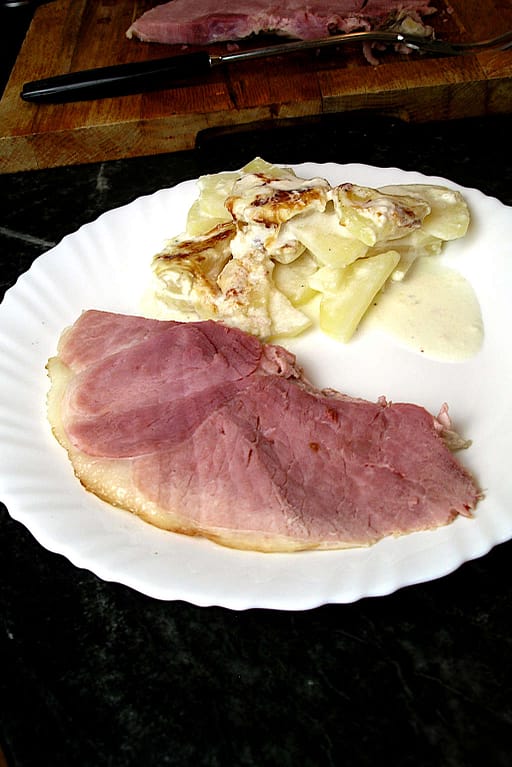Lower-sodium ham! Something amazing happens with this method. Yes, the saltiness is reduced, but the texture of the ham becomes almost silky and succulent too.
I haven’t posted in a couple of weeks, and I apologize. I actually took the photos for this post last Christmas, but so many other things got in the way. Whew! Things are a little more back to normal now, so I’ll be getting back to my usual posting schedule.
So, this method came about not long after I was told to reduce my salt intake. Most things weren’t that big of a deal – just reading the label would show which items exceeded my target goal. But ham of any kind was another matter entirely. It’s normally really high in sodium, though some grocers do carry lower-sodium ham versions.
A Little Experimentation…
But the lower-sodium hams I’ve found in the past were always just boneless portions, and they were quite expensive on a per-pound basis. Not the glorious, bone-in butt-portion hams I like to serve for festive meals. And that always go on sale at around $1.29 to $1.59 per pound around the holidays. What to do?
This was well before food blogging was a thing, and a search of the internet turned up nothing (more on that later). So I came up with the idea of simply soaking the ham in a large amount of water overnight. And it seems to work! At least some of the salt is released into the water, and the saltiness of the ham is much reduced, but something else happens as well.
The texture of the lower-sodium ham changes too. Rather than being kind of flabby and soft, the ham becomes silky, smooth and very delectable. Even if you’re not on a salt-restricted diet, give this recipe a try! I’ve served it to multiple friends, and they all remark about how different and good it is .
Please keep in mind that I can’t tell you the exact salt content that this method produces. I only know that it works okay for me. And I haven’t used this method on a so-called country ham, which is dry-cured, doesn’t require refrigeration, and (I’ve heard) is even saltier than the refrigerated, wet-cured hams.
How to Make Low(er) Sodium Ham
The method couldn’t be much easier though it does require a five-gallon (or larger) food-grade container. We use a stainless steel six-gallon pot that we also use for certain other culinary projects. It also requires a place where the temperature will stay at 40° F or lower overnight and into the next day.
Our garage in December seems to work well. If you have a spare refrigerator you can use that too, but I recommend reinforcing the shelf on which the container will sit with a piece of half-inch or better plywood cut to fit. Water is very heavy, you don’t want to break the shelf!
Simply add the unwrapped ham to the pot, bucket, or other container, and add plain tap water to cover by at least six inches. Cover it with a lid and set it in a cold place as mentioned above. Let it stand for 18 hours or more before you start to cook it.

Then proceed to bake the ham according to the package directions, glazing it if you wish. I’ve found that this method works very well when the ham is baked, However, if the weather is cooperative we prefer to bring it up to serving temperature in the smoker, with fruitwood chunks providing the smoke. (We used wild plum chunks from a tree on our property this year.)
Because the smoker cooks “low and slow,” about 225 to 250° F, the cooking time will be much longer than the ham label directs. We use skewers, kitchen twine, and aluminum foil to help keep the face of the lower-sodium ham from drying out too much.

Other Methods to Make a Lower-Sodium Ham
While I’ve been using this method for 15 years or better, a search on “reduced-sodium ham” yesterday revealed multiple results. How fascinating that so many others have the same concerns! One of the most interesting I found was on Salty Life Mom’s site. Her method also uses a large pot or vessel, but she boils the ham on the stovetop for a period of time. I’ll give it a try one of these days and report back here.
I also wonder how this method would work on a spiral-sliced ham, since the exposed surface area is so much greater. My hunch is that the soaking time would be a LOT less. I’ll give this a try as well, and let you know the results.


